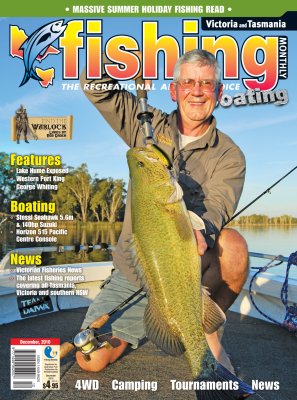Western Portís Royal Fish: King George Whiting by Jarrod Day
 If there is one thing I have learnt about catching whiting, it is to be almost as quiet as a mouse.
If there is one thing I have learnt about catching whiting, it is to be almost as quiet as a mouse.
As the majority of whiting fishing is often undertaken in less than 5m of water and with only a small distance of water between you and where the fish are, loud noises such as banging on the boat, talking loudly or having loud music playing is enough to spook any fish in the ocean.
At the best of times, whiting are very easily spooked and noise is a major contributing factor. Eliminate the noise levels and you're well on the way to catching more fish.
LOCATIONS
While we all enjoy a spot of whiting fishing from now and then, they are a fish with attitude. By this I mean one day you can have a sensational day out finding them on every anchor drop, while the next they are nowhere to be found.
Whiting prefer to feed across sand holes adjacent to vast weed beds where their preferred food source is found. In saying that, larger whiting are often found in the deeper sections of Western Port over solid reef where you'd often target snapper. Providing you do your homework, finding a good patch of fish should become easier.
TOP END
The top end of Western Port is a Mecca for whiting. Specific locations such as the Tyabb and Quail Banks, Tooradin Channel, Browns Reserve, Cockyannes Channel, Charring Cross, Gentle Annie, Irish Jacks and Lyalls Channel are all popular whiting haunts and continue to produce quality fish.
During a flood tide, the banks are covered with water and may only be 5m or shallower. These banks are also covered in seagrasses; the ideal location to find whiting. The most effective technique here is to fish two hours either side of a high tide change.
In saying that, the closer to the 'slack water' you get, the quicker the fish will go off the bite. On the shallow banks the tide strength isn't such a contributing factor and you should be able to get away with using a sinker weight ranging from 2-3oz.
A great way to keep the fish on the bite is to use a concoction of berley, although when the tide is slack, they will go off the bite for 30 minutes or so. Whether it is just mashed up pilchards in a berley pot or pellets mixed with tuna oil, it will do the job.
The only problem with using berley is you will attract stingrays, gummy sharks and the like which may spook the school. If the school does go quiet, it will pay to give it another 30 minutes or so before changing locations. If the fish come back on the bite during this time, stay, if they don't, move.
IRISH JACK GPS MARK: S 38 14.926 E 145 21.868
GENTLE ANNIE GPS MARK: S 38 14.448 E 145 20.327
NORTH ARM
The North Arm encompasses the Eastern Channel, which runs north west alongside French Island and the Middle Spit. This area is heavily affected by the tide, thus allowing some very productive fishing around a tide change. For larger fish, I have found working in depths of 10m during the flood tide to be extremely productive.
If you are fishing in this depth, don't be afraid to slip on a 10oz sinker to keep your bait on the bottom. The whiting are big here and if you're using circle hooks you'll have no worries with the fish staying on the hook.
If you're fishing in the shallows, the top of the flood is better and you can get aw